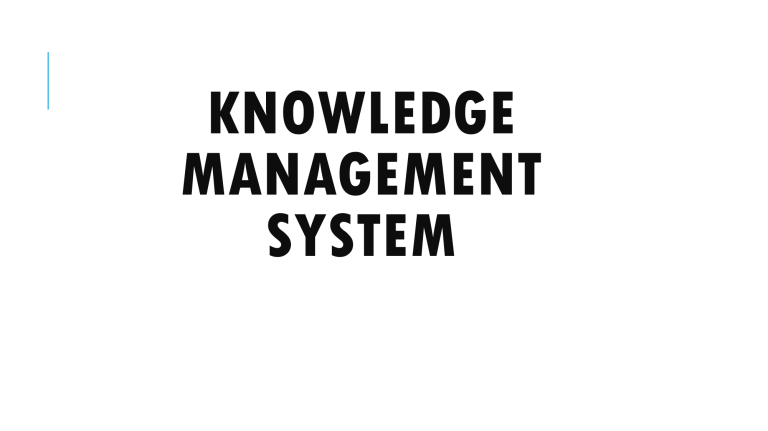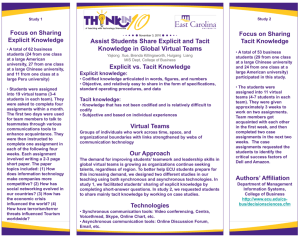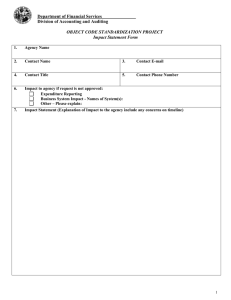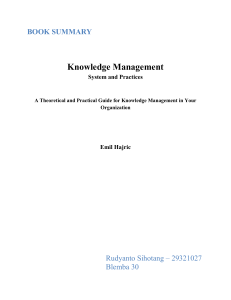
KNOWLEDGE MANAGEMENT SYSTEM KNOWLEDGE Information that is seen, read or understood MANAGEMENT Covers planning, controlling and administration. SYSTEM A group of information or data that works together to provide value or meaningful information WHAT IS KNOWLEDGE MANAGEMENT? Is the collection of processes that govern the creation, dissemination, and utilization of knowledge HOW KNOWLEDGE IS FORMED? DATA INFORMATION KNOWLEDGE KNOWLEDGE HEIRARCHY Expertise Knowledge Information Data FEATURES EXPLICIT KNOWLDGE Tacit Knowledge Tangible Intangible Physical objects, e.g. in documents or database Mental objects, e.g. its in people’s head’s Context independent Context affects meaning Easily shared Sharing involves learning Reproducible Not identically replicated CAPABILTIES OF KNOWLEDGE MANAGEMENT SYSTEM To compete effectively, companies must leverage their existing knowledge and create new knowledge that favorably positions them in their chosen markets. To accomplish this, companies must develop the ability to use prior knowledge to recognize the value of new information, assimilate it, and apply it to new knowledge and capabilities. Many researchers have proposed capabilities influencing knowledge management as preconditions or organizational resources for effective knowledge management. WHY KNOWLEDGE MANAGEMENT? To share knowledge, a company creates exponential benefits from the knowledge as the people learn from it. To build better sensitivity to “brain drain” To reacting to new business opportunities THREE KEY REASONS WHY ACTIVELY MANAGING KNOWLEDGE IS IMPORTANT TO A COMPANY’S SUCCESS ARE: 1.) facilities decision-making capabilities 2.) builds learning organizations by making learning routine 3.) stimulate cultural change & innovation TYPES OF KNOWLEDGE MANAGEMENT SYSTEMS ENTERPRISE – WIDE KNOWLEDGE MANAGEMENT SYSTEMS – general purpose integrated, firm-wide efforts to collect, store, disseminate, and use digital content and knowledge. KNOWLEDGE WORK SYSTEMS – specialized workstations and systems that enables scientists, engineers, and other knowledge workers to create and discover new knowledge. INTELLIGENCE TECHNIQUES – tools fro discovering patterns and applying knowledge to discrete decisions and knowledge domain. DEVELOPMENT OF KNOWLEDGE MANAGEMENT SYSTEM Knowledge creating Knowledge sharing Knowledge structuring Knowledge using Knowledge auditing CLASSIFICATION OF KNOWLEDGE CREATION TACIT KNOWLEDGE That type of knowledge which people carry in their mind and is therefore, difficult to access. EXPLICIT KNOWLEDGE That type of knowledge which has been or can be articulated, codified, and stored in certain media. CLASSIFICATION OF KNOWLEDGE SHARING Social communication infrastructure Technical communication infrastructure CLASSIFICATION OF KNOWLEDGE STRUCTURING Information Mapping – a process by which organizations can identify and categories knowledge assets within their organization. Information Storaging – contains knowledge repositories such as database, data warehouses, and information centres and indicates electronic environment or organizational memory. Information Retrieving – in this stage, knowledge is stored and retried via information retrieval systems KNOWLEDGE USING Product Service Process KNOWLEDGE AUDITING Means what amount of knowledge can be used in organizations products, services and process. WHY THE ORGANIZATIONS USE KNOWLEDGE? Knowledge can be used for determining organizations work processes and making strategies for sustainable competitive advantage. Knowledge can be used for designing and marketing the product. Knowledge playa a critical role of an organizations service quality. THANK YOU TEST I. IDENTIFICATION 1.) Is the collection of processes that govern the creation, dissemination, and utilization of knowledge 2.) Identified and codified 3.) A group of information or data that works together to provide value or meaningful information 4.) Lives in people and their practices, Experiences, Competence, Commitment, Deeds and Thoughts. 5.) Information that is seen, read or understood 6.) Covers planning, controlling and administration. 7.) a process by which organizations can identify and categories knowledge assets within their organization. 8.) contains knowledge repositories such as database, data warehouses, and information centres and indicates electronic environment or organizational memory. 9.) In this stage, knowledge is stored and retried via information retrieval systems 10.) Means what amount of knowledge can be sued in organizations products, services and process. TEST II. ENUMERATION 1-3) What are the three types of KNOWLEDGE MANAGEMENT SYSTEM? 4-8) Enumerate the five DEVELOPMENTS OF KNOWLEDGE MANAGEMENT SYSTEM. 9-10) Give at least two key reasons why actively managing knowledge is important to a company’s success. ANSWERS TEST I. 1. Knowledge Management 2. Explicit Knowledge TEST Ii. 1. ENTERPRISE – WIDE KNOWLEDGE MANAGEMENT SYSTEMS 2. KNOWLEDGE WORK SYSTEMS 3. INTELLIGENCE TECHNIQUES 4. Knowledge creating 4. Tacit Knowledge 5. Knowledge sharing 5. Knowledge 6. Knowledge structuring 6. Management 7. Knowledge using 7. Information Mapping 8. Knowledge auditing 8. Information Storaging 9. facilities decision-making capabilities 9. Information Retrieving 10. builds learning organizations by making learning routine 10. Knowledge Auditing stimulate cultural change & innovation 3. System



